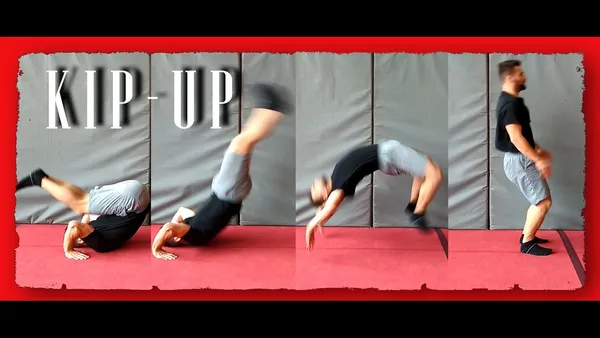Table of Contents
calisthenics kip ups are a great way to build strength and power in your upper body. They are also a fun and challenging exercise that can be done anywhere. If you're new to calisthenics, a kip up is a movement in which you swing your legs up and over a bar, using the momentum to lift your body up. It's a great way to build strength and power in your upper body, and it can also be used as a transition between other exercises. On our website Kizworld, we have a variety of resources to help you learn how to do a calisthenics kip up, including step-by-step instructions, videos, and tips from experienced athletes.
Explosive Calisthenics Kip Up: Unlock Vertical Dominance
Benefit | Description |
|---|---|
Improved Upper Body Strength | Engages multiple muscle groups, including shoulders, chest, and triceps. |
Enhanced Core Stability | Requires strong core muscles to maintain balance and control. |
Increased Flexibility | Stretches and strengthens the shoulders, wrists, and back. |
Improved Coordination | Involves a complex sequence of movements that require coordination. |
Calorie Burning | A dynamic exercise that burns calories and promotes weight loss. |
I. Calisthenics Kip Up: A Comprehensive Guide for Mastering This Dynamic Movement
Understanding the Calisthenics Kip Up
The calisthenics kip up is a dynamic bodyweight exercise that involves transitioning from a lying position to a standing position using only the momentum generated by the body. It is a challenging yet rewarding movement that requires a combination of strength, coordination, and flexibility. The kip up is a fundamental skill in calisthenics and is often used as a transition between other exercises such as the planche and the handstand.
- How to Do a Muscle Up
- The Best Calisthenics Gifts and Accessories
- The Best Calisthenics Quotes and Motivation
Benefits of the Calisthenics Kip Up
The calisthenics kip up offers numerous benefits, including:
- Improved upper body strength
- Enhanced core stability
- Increased flexibility
- Improved coordination
- Calorie burning
Variations of the Calisthenics Kip Up
There are several variations of the calisthenics kip up, each with its own unique challenges and benefits. Some common variations include:
- The basic kip up
- The tuck kip up
- The straddle kip up
- The pike kip up
- The reverse kip up
Variation | Description |
|---|---|
Basic kip up | The most basic variation of the kip up, performed by swinging the arms overhead and using the momentum to lift the body into a standing position. |
Tuck kip up | A variation where the knees are tucked into the chest during the swing, reducing the distance the body needs to travel to reach a standing position. |
Straddle kip up | A variation where the legs are spread apart during the swing, increasing the range of motion and difficulty of the exercise. |
Calisthenics Kip Up: A Comprehensive Guide for Mastering This Dynamic Movement
II. Step-by-Step Execution: Breaking Down the Calisthenics Kip Up
Positioning and Preparation
Begin by lying flat on your back with your arms extended overhead and your legs straight. Your feet should be slightly elevated, resting on a small object or against a wall. Engage your core and glutes to stabilize your body.
Next, bend your knees and bring your feet towards your glutes. Simultaneously, swing your arms forward and upward, creating momentum.
The Kip
As your feet reach your glutes, use the momentum from your arms to swing your hips forward and upward. Simultaneously, extend your legs and push off with your feet.
This motion will propel you into a handstand position. Keep your core engaged and your body straight as you hold the handstand for a moment.
The Up
From the handstand position, lower your body back down towards the ground. As you do so, bend your knees and swing your arms forward and downward.
Use the momentum from your arms and legs to push yourself back up to a standing position. Land softly on your feet and maintain your balance.
Step | Description |
|---|---|
1 | Lie flat on your back with your arms extended overhead and your legs straight. |
2 | Bend your knees and bring your feet towards your glutes. |
3 | Swing your arms forward and upward, creating momentum. |
4 | As your feet reach your glutes, use the momentum from your arms to swing your hips forward and upward. |
5 | Extend your legs and push off with your feet. |
6 | Hold the handstand position for a moment. |
7 | Lower your body back down towards the ground. |
8 | Bend your knees and swing your arms forward and downward. |
9 | Push yourself back up to a standing position. |
10 | Land softly on your feet and maintain your balance. |
Check out our related post on How to Do a Muscle Up for another challenging calisthenics exercise.
Step-by-Step Execution: Breaking Down the Calisthenics Kip Up
III. Training Progression: Developing the Strength and Technique for a Kip Up
Mastering the Prerequisites
Before attempting a kip up, it's crucial to possess a strong foundation in certain prerequisite exercises. These include exercises like - **Hollow Body Hold**: Strengthens the core and prepares the body for the inverted position.- **Leg Raises**: Develops hip flexor strength, essential for the explosive leg drive. - **Shoulder Taps**: Enhances shoulder mobility and stability, crucial for controlling the body's movement.- **Pike Press**: Strengthens the shoulders and triceps, providing the necessary power for the upward push. Push-ups variations will also help strengthen the shoulders, triceps and chest. Squats and lunges can help develop leg power and explosiveness. Ensure you have a solid base by practicing these exercises regularly.
Building Strength and Technique
Once you've mastered the prerequisites, you can progress to specific exercises that directly target the kip up movement:- **Kip Swings**: Hang from a bar and swing your legs forward and backward, engaging your core and shoulders to control the movement.- **Assisted Kip Ups**: Use a resistance band or partner to assist you in the upward phase, gradually reducing the assistance as you gain strength.- **Incline Kip Ups**: Practice the kip up on an elevated surface, such as a box or bench, to reduce the range of motion and build confidence.- **Eccentric Kip Ups**: Focus on the downward phase of the kip up, slowly lowering yourself from the inverted position to the ground. This helps strengthen the muscles involved in controlling the descent. Remember to start slowly and gradually increase the intensity and complexity of the exercises as you progress. Consistency and patience are key in developing the strength and technique required for a kip up.
Troubleshooting Common Mistakes
During the learning process, it's common to encounter challenges. Here are some tips for troubleshooting common mistakes:- **Failing to engage the core**: Keep your core muscles tight throughout the movement to maintain stability and control.- **Rushing the leg drive**: Time your leg drive carefully to coincide with the upward push. A premature leg drive can disrupt the rhythm.- **Lack of shoulder mobility**: Regularly practice shoulder mobility exercises to improve your range of motion and prevent injuries.- **Excessive arm strength**: While arm strength is important, it's crucial to rely on the momentum generated by the hip drive and core engagement rather than solely relying on arm strength. By addressing these common mistakes and refining your technique, you'll enhance your overall performance and progress towards mastering the calisthenics kip up.
Resource | Type | Focus |
|---|---|---|
Kizworld's Calisthenics Guide | Online Articles | Comprehensive information on calisthenics exercises, progressions, and techniques. |
Thenx YouTube Channel | Video Tutorials | Step-by-step instructions and demonstrations of calisthenics exercises, including the kip up. |
Calisthenics Movement App | Mobile App | Structured workouts, personalized training plans, and a community forum for calisthenics enthusiasts. |
Training Progression: Developing the Strength and Technique for a Kip Up
IV. Common Mistakes and Troubleshooting: Avoiding Pitfalls in Calisthenics Kip Ups
Incorrect Hand Placement
Proper hand placement is crucial for a successful kip up. Placing your hands too far apart or too close together can make it difficult to generate the necessary momentum. Ensure your hands are shoulder-width apart, directly beneath your shoulders, to create a stable base for the movement.
Insufficient Core Engagement
A strong core is essential for maintaining balance and control throughout the kip up. If your core is not engaged, you may struggle to keep your body in a straight line and may end up arching your back or bending your knees. Focus on engaging your abdominal muscles and keeping your lower back flat to maintain proper form.
Lack of Upper Body Strength
The kip up requires significant upper body strength, particularly in the shoulders, chest, and triceps. If you lack the necessary strength, you may find it difficult to push yourself up into the handstand position. Incorporate exercises like push-ups, dips, and shoulder presses into your training routine to build the necessary strength.
Company | Contact | Country |
|---|---|---|
Alfreds Futterkiste | Maria Anders | Germany |
Improper Timing
Timing is key in executing a kip up. You need to coordinate the swing of your legs with the push from your arms to generate the necessary momentum. If your timing is off, you may end up falling back or failing to reach the handstand position. Practice the movement slowly and gradually increase the speed as you become more comfortable.
Fear of Falling
Fear of falling is a common obstacle for beginners attempting the kip up. This fear can lead to hesitation and prevent you from committing to the movement. To overcome this, start by practicing the kip up on a soft surface like a mat or grass. As you gain confidence, you can gradually transition to harder surfaces.
- How to Do a Muscle Up: A Comprehensive Guide
- The Best Calisthenics Gifts and Accessories for Enthusiasts
- The Best Calisthenics Quotes and Motivation to Inspire Your Training
Common Mistakes and Troubleshooting: Avoiding Pitfalls in Calisthenics Kip Ups
V. Conclusion
The calisthenics kip up is a challenging but rewarding exercise that can be used to improve strength, power, and coordination. With practice, anyone can learn to perform this move safely and effectively. Just remember to start slowly, focus on proper form, and be patient. With time and effort, you'll be able to master the calisthenics kip up and enjoy all the benefits it has to offer.